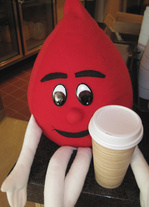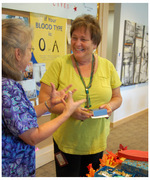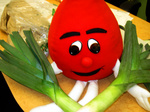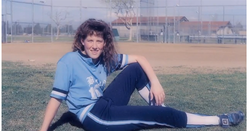December 2010
Free Coffee to Donors - Scarlett is Full of Beans
By Scarlett O'Negative
Once again Stanford Blood Center is offering a complementary Peet’s Coffee drink coupon for all donors who donate at a Stanford Blood Center on either Thursday, 12/30 and Friday, 12/31. We love healthy donors and it appears that coffee has health benefits.
According to Neil Osterwiel of WebMD, coffee drinkers are:
• less likely to have type 2 diabetes, Parkinson's disease, and dementia
• have fewer cases of certain cancers, heart rhythm problems, and strokes
Coffeeresearch.org has a great map of the coffee growing regions round the world. Wow, look at Brazil’s exports. That’s a lot of caffeine to make Scarlett Samba.
Scarlett Invites You to the Movies During the Holidays
By Scarlett O'Negative
My friends at Stanford Blood Center realize that people are busy during the holidays, so they are offering a free movie tickets to every donor who donates at a Stanford Blood center in Palo Alto or Mountain View between Monday, December 20th and Saturday, January 8th.
Personally, I want to see Black Swan. I’ve always wanted to be a ballerina – must be something to do with my natural grace. Move aside Natalie Portman, Scarlett’s ready to pirouette.
Speaking of Natalie Portman, apparently she trained intensely for the role in the movie, starting a progressively demanding dance training a year before shooting began. This is the same kind of energy and attention that goes into training a phlebotomist at Stanford Blood Center.
Our training team, Mary and Wendy, put trainee phlebotomists through 4 months of rigorous training, including sticking the trainers themselves 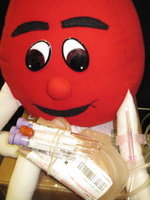 with a practice venipuncture. Now that’s confidence! The better the training, the less ouch!
with a practice venipuncture. Now that’s confidence! The better the training, the less ouch!
San Bruno Fire Destroys Home, Not Family
By Erin Crager, Marketing Intern, Stanford Blood Center
Carlene Vasquez, Autologous, Designated & Therapeutic Donations (OADD) Manager knows what it feels like to lose everything. Few people can truthfully say that. On September 9th, the house she and her husband lived in for 32 years was destroyed by the San Bruno fire, after a 30-inch gas pipe exploded into flames just down the street.
Her husband, Arturo, who was in the house at the time, made it out alive and Carlene, who was at her weekly bingo night, was soon whisked off by her daughter who came to break the news. The two were reunited with Arturo at the local strip mall which had been set up as a temporary relief zone.
Carlene spent the night with her immediate family, save one in law and couldn’t have been more comforted. Having all her family together under one roof was all she needed.
As the OADD manager for Stanford Blood Center, Carlene is well aware of how much family matters, especially when one of those family members is seriously ill and in need of blood.
Helping to coordinate blood donation for someone else’s relative gives Carlene the chance to help people come together to support their family members. Not all too dissimilar from how her family and friends came together to support her after the fire. Her story serves as a testament to how families and friends come together when someone is truly in need.
Carlene recently spent Thanksgiving at her sister’s in Auburn with relatives, a long-time family tradition. Christmas has always been held at her house, and though her temporary home in South San Francisco may not have all the subtle details and imperfections she’s come to cherish, she’ll be decking the brightly lit rooms with festive familiarities. And most importantly she’ll have all her family under one roof.
In the picture above, Carlene opens up boxes of jewelry that were dropped off by someone who read her story in the Mercury News. Click here to read the article.
How Long Do Red Blood Cells Live?
By Billie Rubin, Hemoglobin’s Catabolic Cousin, reporting from the labs of Stanford Blood Center
A unit of red blood cells (RBCs) expires in 35 or 42 days because of the type of anticoagulant in the bag. But in real life RBCs live about 120 days (except for Scarlett O’Negative, she’s immortal). When they get old and their membrane starts to show wear and tear (like most of us), they get removed from the blood circulation in the spleen, liver and bone marrow at about the same rate as new ones get produced. It's the original "sustainable" environment.
There are millions of RBCs in just one drop of blood. People who live at higher altitudes have more (like in the mountains of Peru). They are produced in the bone marrow of large bones at a rate of 2 million per second. In the minute it took you to read this, you made 120 million of them!
Wikileaks and Leeks of a Different Kind
By Scarlett O'Negative
We’ve heard a lot recently about Wikileaks, but this shouldn’t overshadow another kind of leek, the worthy vegetable.
Leeks are rich in the flavonoid kaempferol, manganese, vitamin B6, vitamin C, folate, and iron. According to the food magazine, Gayot, the venerable leek is thought to have these health benefits –
• Lower LDL (bad) cholesterol
• Raise HDL (good) cholesterol
• Help stabilize blood sugars
• Reduce the risk of ovarian cancer
• Strengthen the immune system
Pretty impressive! Leeks may be part of the arsenal of helpful foods which keep blood donors healthy over the holidays. We’ll need you.
Does anyone have a good leek recipe to share?
A Daughter's Legacy
Below is an article written by Dean Eller, CEO of Central California Blood Center, about his daughter's battle with leukemia and his commitment to carrying on her legacy. Thank you, Dean, for sharing your story with our audience.
“There’s no easy way to tell you this,” lamented the doctor that day in January of 1992. “It’s what we feared. A very aggressive type of leukemia. One-third of those diagnosed die within 30 days. I’m sorry.”
My wife, Claudia, and I sat in shock. Words choked within us. How could this be? Our daughter, Jenny, was an attractive high-school senior—a straight-A student! As the all-star catcher on the softball team at Bullard High School in Fresno, California, she was being recruited by several Division I universities. As we drove home from the doctor’s office, I asked Jenny what she thought. Without hesitation she said, “I just don’t want you and Mom to be sad...because I’m not sad. I’m a little nervous about the treatment, but I’m not sad! I know God is in control, and whatever the outcome, I know I am in His will.”
Her composure stunned me. At a time when most teenagers would be falling apart, my daughter picked me up, put me on her shoulders and carried me. For the next four years, as she fought this cancer, she showed me what courage—and life—is all about.
Six powerful words
Within days, Jenny began chemotherapy. Because the treatment wiped out her body’s ability to make blood, she received at least two transfusions a week. Over time she would use hundreds and hundreds of pints of life-saving blood.
I’d first seen the need for blood in Vietnam when I was 21 and serving as a medic, but I’d never known anyone like Jenny who needed so much blood to stay alive. Not long after she was diagnosed, our local blood bank asked Jenny to attend its annual appreciation luncheon to thank the donors. Claudia and I remember that day clearly. Jenny wore a long dress, and her head was bald. She walked up to the podium and looked out at the 800 regular donors in the audience, held out her hands, and her chin began to quiver: “Thank you . . . for letting me live.”
Six words. The most powerful words a blood donor can hear.
“My body no longer makes blood,” Jenny explained, “and every ounce in me belongs to someone else. Your blood may be coursing through my veins right now! Thank you for letting me live.”
Jenny understood that those donors were keeping her alive, and she became passionate about increasing the blood supply in our community.
For the next four years, Jenny became the official spokesperson for the Central California Blood Center. She spoke to service groups, schools, and churches throughout the area. She did media interviews and commercials, and even called potential blood donors—sometimes from her hospital bed—all while fighting this insidious disease.
Four precious years
When Jenny died on October 28, 1995, a month before her 22nd birthday, she lost her battle with leukemia, but she fulfilled her purpose in life. Just before she died, I promised her that I would carry on that work. To me, it was like receiving a spiritual transfusion.
At Jenny’s memorial service, I urged people to give blood in her memory and to consider becoming regular donors (giving every eight weeks). For many, the importance of donating blood finally hit home. I gave my first speech two days after we buried Jenny, speaking in her place at a Rotary Club meeting.
Hundreds of faithful donors kept our daughter alive and gave us almost four more years together—a gift beyond measure. Four precious years that Jenny enjoyed as she finished high school and started college, an optimistic pre-med major. Four years of celebrating birthdays, Christmases, and family outings. That’s what blood donors gave us. Not just blood, but four more years for this father to watch his daughter mature into a young woman and fall in love with a wonderful young man. Four more years of father-daughter talks into the wee hours of the morning, just the two of us.
Not just blood, but memories to last a lifetime.
The Blood Banker
In November 1999 I became president and CEO of the Central California Blood Center and worked hard to turn around the Center’s blood deficit. In the last six years—in what I believe is the direct confirmation of my calling—we have not had to import even one pint! In fact, today we export between 500 and 1,000 units of blood every month to other blood centers in need.
Individual names aren’t available, but I know that thousands and thousands of lives around the country have been prolonged or saved because Jenny fulfilled her purpose in life and helped me rediscover mine.
Johnson & Johnson put together a video about Jenny’s life which you can watch on YouTube here.

